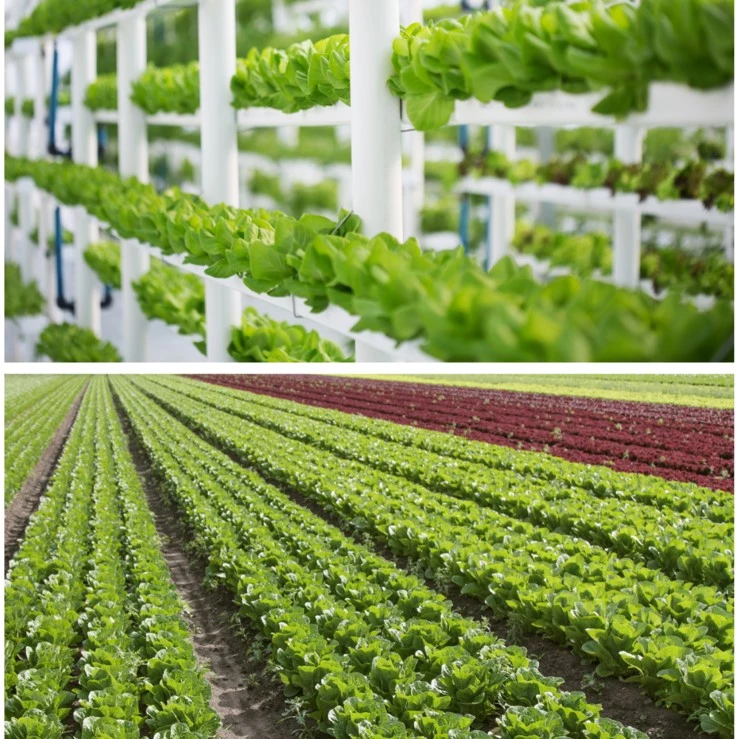Hydroponic vs. Soil Cultivation
Hydroponic farming mitigates many issues and stressors that traditional farmers face. These issues can include reliance on the weather, soil erosion, poor drainage, and unsuitable soil compaction or nutrient density. Hydroponic farming allows for less usage of water than irrigation systems. Hydroponics not only recycle water, but its controlled system will also enable growers to monitor and customize the distribution of different nutrient levels to crops. Hydroponic systems are closed environments, offering a more substantial range of control for growers in each aspect of care for their plants. To learn more about the different hydroponic systems available, check out our blog on Types of Indoor Farming.
Are there differences among hydroponically grown fruit and vegetables versus those grown in soil? Keep reading to find out!
Sensory profile:
How a fruit or vegetable looks, smells and tastes greatly influences consumers’ choice of purchase. A tomato in the grocery store could be the most beautiful tomato you have ever seen, but it may completely lack flavour. Vice versa, the most unattractive strawberry may be the tastiest. But is there a difference in appearance, flavour and smell in fruits and vegetables grown hydroponically compared to those cultivated from the soil?
Among microgreens, specifically broccoli microgreens, studies have shown no significant differences between appearance, flavour and smell [1]. In contrast, hydroponically grown tomatoes appear more vibrant with a more robust flavour profile. However, no significant difference was noted concerning smell compared to tomatoes grown in soil [2]. In another study, most participants (70%) preferred the taste of hydroponically grown strawberries to those grown in soil [3].
The differences depend on the plant itself. However, growth in soil or the absence of it can influence the appearance, taste and smell of fruits and vegetables.
Crop Yield and Environmental Impact:
Hydroponic farms have an advantage over traditional farms, which is the ability to grow vertically (Figure 1). Additionally, hydroponic systems are highly controlled environments where the pH, salinity, nutrient density, temperature and humidity are all controlled (see our blog post on indoor farms to learn more.) This allows for the grower to have the power to provide what the plants need exactly, all while avoiding external weather concerns.
When it comes to yield, hydroponically grown fruits and vegetables tend to be higher than that of soil cultivated. Such is the case for hydroponically-grown strawberries and bell peppers [4; 5]. Hydroponically grown plants can also have a higher survival rate, such as strawberries, with an 80% survival compared to 46% grown in soil [4]. However, concerning individual fruit and vegetable size, those grown in soil tend to be larger and denser [4].

When it comes to environmental impact, it may surprise you. Still, hydroponic farms utilize less water and enable the growth of more plants per square footage in comparison to field agriculture (Table 1).

*This table is from Sardare and Admane, 2013 [6]
We provide great overviews of many agricultural microorganisms, both in hydroponics and soil. Subscribe to stay updated!
Nutrients:
Since the quality and nutrient density of fruits and vegetables are influenced by their environment, it is not a surprise that two very different growth environments would result in different nutrient compositions for the same plant.
Regarding basil grown under hydroponic conditions compared to basil grown in soil, there was an increase in antioxidant levels, vitamin C, vitamin E, phenols, lipoic acid and rosmarinic acid [7].
Similarly, strawberries grown in hydroponic conditions have higher nutrient densities as well as higher traces of essential and non-essential mineral contents (i.e. Fe, Zn, B, As, Se, Ni, V, Cr, Al, Cd, Mn, Co and Pd), and major minerals (i.e. K and P), compared to strawberries grown in soil [8]. The benefits of these minerals and nutrients are shown in Table 2.
|
Mineral/metal |
Abbreviation |
Essential/Non-Essential |
|
Aluminum |
Al |
Non-Essential |
|
Arsenic |
As |
Non-Essential |
|
Boron |
B |
Non-Essential |
|
Cadmium |
Cd |
Non-Essential |
|
Cobalt |
Co |
Essential |
|
Chromium |
Cr |
Essential |
|
Iron |
Fe |
Essential |
|
Potassium |
K |
Essential |
|
Manganese |
Mn |
Essential |
|
Nickel |
Ni |
Essential |
|
Phosphorus |
P |
Essential |
|
Palladium |
Pd |
Non-Essential |
|
Selenium |
Se |
Essential |
|
Vanadium |
V |
Non-Essential |
|
Zinc |
Zn |
Essential |
Table 2. Essential and non-essential minerals are higher in hydroponic strawberries compared to soil-grown strawberries
Hydroponically grown soybeans are also more nutrient dense than their soil-cultivated counterparts. Soybeans grown hydroponically had higher fats, dietary fibre and phytic acid concentrations and lower isoflavones concentrations, and the protein concentration remained unchanged compared to soybean grown in soil [9].
Cost:
Getting started in hydroponics can be an expensive endeavour. The price range varies due to all the available options on the market. You could make a hydroponic or aquaponic system home with materials you find around the house or purchase top-of-the-line equipment to commercialize produce.
When it comes down to comparing the price per product for hydroponically grown and soil grown, hydroponic tends to be a little more expensive. The reason for this is because of the constant monitoring of the system and tight regulations that are needed to ensure optimal growth of the plants. For example, the fixed cost for growing hydroponic strawberries is around $593.80, including plumbing, air pumps, netting, pH and ppm meters, and hydrotons [4]. The fixed cost for soil-grown strawberries is around $270.59, including potting soil, plumbing, water reservoir and pumps, and power cords [4]. Although the startup costs are higher for hydroponic systems, they can last through more seasons without replacing the soil [4].
Overview:
At the end of the day, whether you eat hydroponically grown fruits and vegetables or those grown in soil, you will provide your body with the nutrients it needs to keep going. However, keeping sustainability in mind and being a conscious consumer, some of the points mentioned above may sway your decision. Hydroponic farms are increasing in popularity, and with more abundance comes a decrease in cost and an increase in accessibility.
No matter what decision you make, keeping it local is always a good idea.
References:
- Chen, H., Tong, X., Tan, L., & Kong, L. (2020). Consumers’ acceptability and perceptions toward the consumption of hydroponically and soil grown broccoli microgreens. Journal of Agriculture and Food Research, 2, 100051. https://doi.org/10.1016/j.jafr.2020.100051
- Korčok, M., Vietorisová, N., Martišová, P., Štefániková, J., Mravcová, A., & Vietoris, V. (2021). Aromatic profile of hydroponically and conventionally grown tomatoes. Applied Sciences, 11(17), 8012. https://doi.org/10.3390/app11178012
- Treftz, C., Zhang, , & Omaye, S. T. (2015). Comparison between hydroponic and soil-grown strawberries: Sensory attributes and correlations with nutrient content. Food and Nutrition Sciences, 06(15), 1371–1380. https://doi.org/10.4236/fns.2015.615143
- Treftz, C., Omaye, S. T. (2015). Comparison between hydroponic and soil systems for growing strawberries in a greenhouse. International Journal of Agricultural Extension, 03 (03) 195-200.
- Albaho, M., Thomas, B., & Christopher, A. (2008). Evaluation of hydroponic techniques on growth and productivity of greenhouse grown bell pepper and strawberry. International Journal of Vegetable Science, 14(1), 23–40. https://doi.org/10.1080/19315260801890492
- Sardare, M. D., & Admane, S. V. (2013). A review on plant without soil – hydroponics. International Journal of Research in Engineering and Technology, 02(03), 299–304. https://doi.org/10.15623/ijret.2013.0203013
- Sgherri, C., Cecconami, S., Pinzino, C., Navari-Izzo, F., & Izzo, R. (2010). Levels of antioxidants and nutraceuticals in basil grown in hydroponics and Soil. Food Chemistry, 123(2), 416–422. https://doi.org/10.1016/j.foodchem.2010.04.058
- Jeon, S. H., Kuppusamy, S., Yoon, Y.-E., Kim, H. T., & Lee, Y. B. (2018). Are there as many essential and non-essential minerals in hydroponic strawberry (fragaria ananassa L.) compared to those grown in soil? Biological Trace Element Research, 187(2), 562–567. https://doi.org/10.1007/s12011-018-1394-y
- Palermo, M., Paradiso, R., De Pascale, S., & Fogliano, V. (2011). Hydroponic cultivation improves the nutritional quality of soybean and its products. Journal of Agricultural and Food Chemistry, 60(1), 250–255. https://doi.org/10.1021/jf203275m
![]()
Becky Anderson is a Lab expert and Science Communicator at Healthy Hydroponics




